Safe Routes to School (SRTS) programs protect students, families, and faculty by making their trips to/from school safer and more efficient. They also encourage physical activity like walking, biking, and rolling, reduce transportation-related costs throughout your community, and promote a more sustainable future.
Here, we share five tools to support your SRTS efforts – whether starting from square one or re-evaluating your current program. We also share why SRTS programs are so timely and the benefits SRTS projects bring to your community.
Have questions? Interested in learning more? Let’s connect! Share your information at the bottom of this article, and we’ll be in touch shortly.
What is an SRTS program? Who does it serve?
SRTS is a federal program operated through state departments of transportation (DOTs) that encourages walking, biking, and rolling to school through street improvement projects, safety education, incentives, and enforcement (e.g., traffic signals, roadside signs, local law enforcement support).
An SRTS program is often led and implemented by a DOT, regional or metropolitan planning organization, local government, or school district.
SRTS programs and solutions are being integrated in communities throughout the U.S., in rural and urban areas, wealthy and low-income, and at scales of all sizes. A small-scale program can be as simple as community education. A large-scale project may include infrastructure changes as vast as installing bicycle lanes, multi-use trails, improved pedestrian crossings, plazas, and boulevards.
What are the benefits? Why is SRTS so timely?
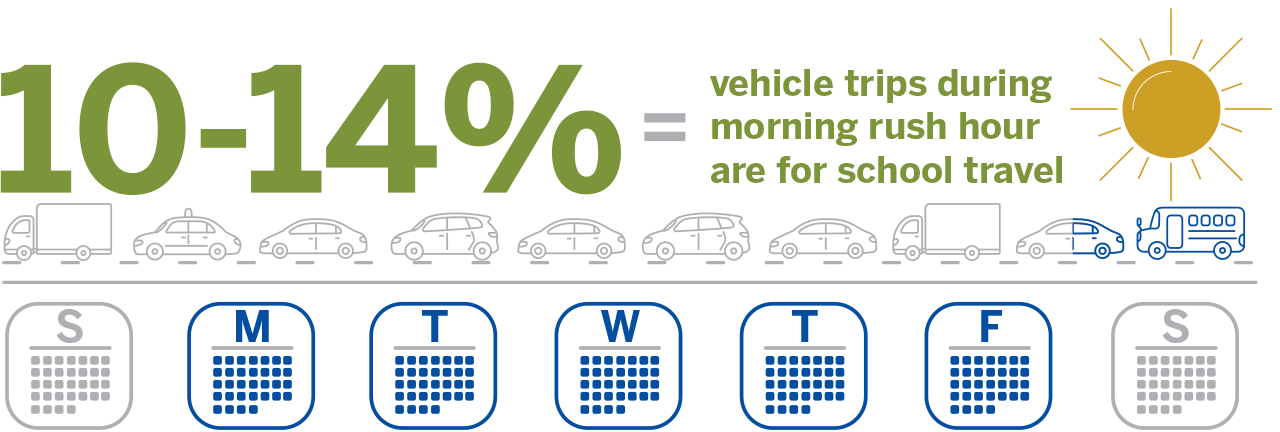
According to the U.S. Department of Transportation, up to 14% of our country’s morning rush hour vehicle traffic involves school-related travel – an eye-opening number and one that continues to rise. The pandemic has also reduced physical activity among kids due to online schooling. Many families are still trying to reverse this trend even as schools have reopened. One strategy to get kids active is by developing an SRTS program for your school or school district.
But SRTS goes far beyond safety for children! SRTS programs play a pivotal role in communities’ efforts to become more inviting, accessible, and inclusive. Beyond health and safety benefits for kids, the impacts of an SRTS program include:
- Improved traffic operations and safety.
- Reduced transportation costs for school districts, students, and families.
- Less pollution from exhaust; more sustainable and climate resilient communities.
- Social and health equity to provide underserved communities and schools with accessible, safe, and complete streets, as well as healthy transportation designs.
- Designs that follow nationally recognized design principles help communities provide environments that are equally accessible and comfortable for users of all abilities and ages.
Safe Routes to School Multimodal Improvement Project | Denver, CO
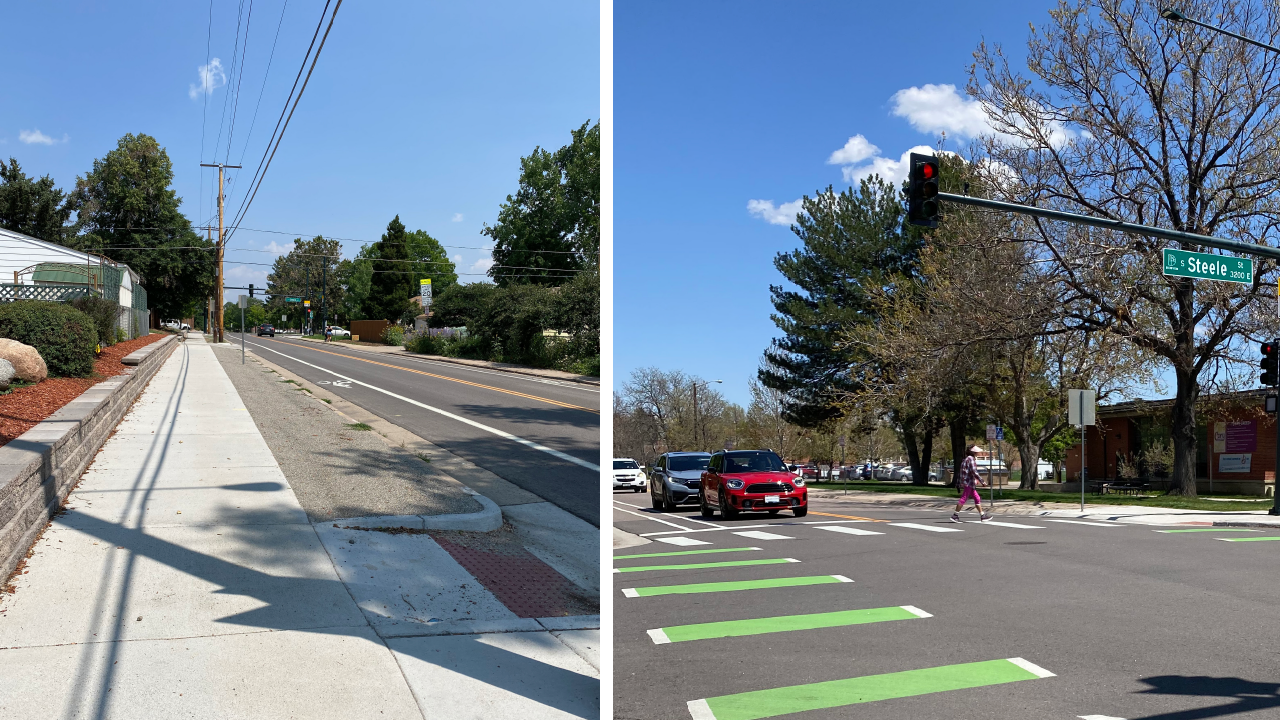
5 tools to guide your SRTS program
There is no one-size-fits-all approach to developing an SRTS program. Each community is unique in terms of transportation conditions, geographic and population size, socioeconomic status, connectivity, and budget.
As you begin or reexamine your SRTS programs, here are five tools that can help your community improve and further inform its efforts.

1. Obtain local support
Gaining support from local stakeholders is critical to the long-term success of all SRTS efforts. This provides your community with a feeling of ownership and transparency around any improvements you make. Buy-in also supports your ability to move key initiatives forward.
One way to achieve local support is by creating a team of diverse stakeholders and/or engaging and seeking input from a similarly diverse group. From our experience leading clients through the development of SRTS programs, parties to consider include:
- Local school district leaders – superintendent, transportation director
- Local school leaders – principal, parents, teachers, students, crossing guards
- City officials – law enforcement officers, city engineer, city planner
- Other community groups – local business leaders, representatives for people with disabilities, neighborhood association leaders, bicycle/pedestrian advocacy groups
Many DOTs have helpful guides available to support your SRTS engagement and planning efforts. For example, MnDOT shared a report titled Engaging Stakeholders in the Safe Routes to School Planning Process: A Guide for Minnesota SRTS Partners. The Colorado DOT offers similarly helpful resources, including its five-year strategic plan, how to participate in Walk and Bike to School Colorado, and online SRTS trainings.
Explore your state DOT or regional planning commission for similar resources and helpful ways to engage, plan, and connect with the community!
2. Conduct a walk/bike audit to identify improvement opportunities
Before moving forward with any SRTS initiative, you need to evaluate and document the existing environment and how it affects students traveling to and from school. One immediately actionable and insightful method is conducting a walk/bike audit.
A walk/bike audit is a field visit to your school and the surrounding area. During the audit, you will document factors that support or detract from bicycle and pedestrian safety. Factors can include existing facilities, the presence of crossing guards, lighting, traffic volume and speed, on-street bike lanes, signage, and the overall comfort of the surrounding area. These audits are a great way to engage your community and stakeholders as you seek to share, ask, listen, and learn.
Some helpful questions to ask and answer during your evaluation:
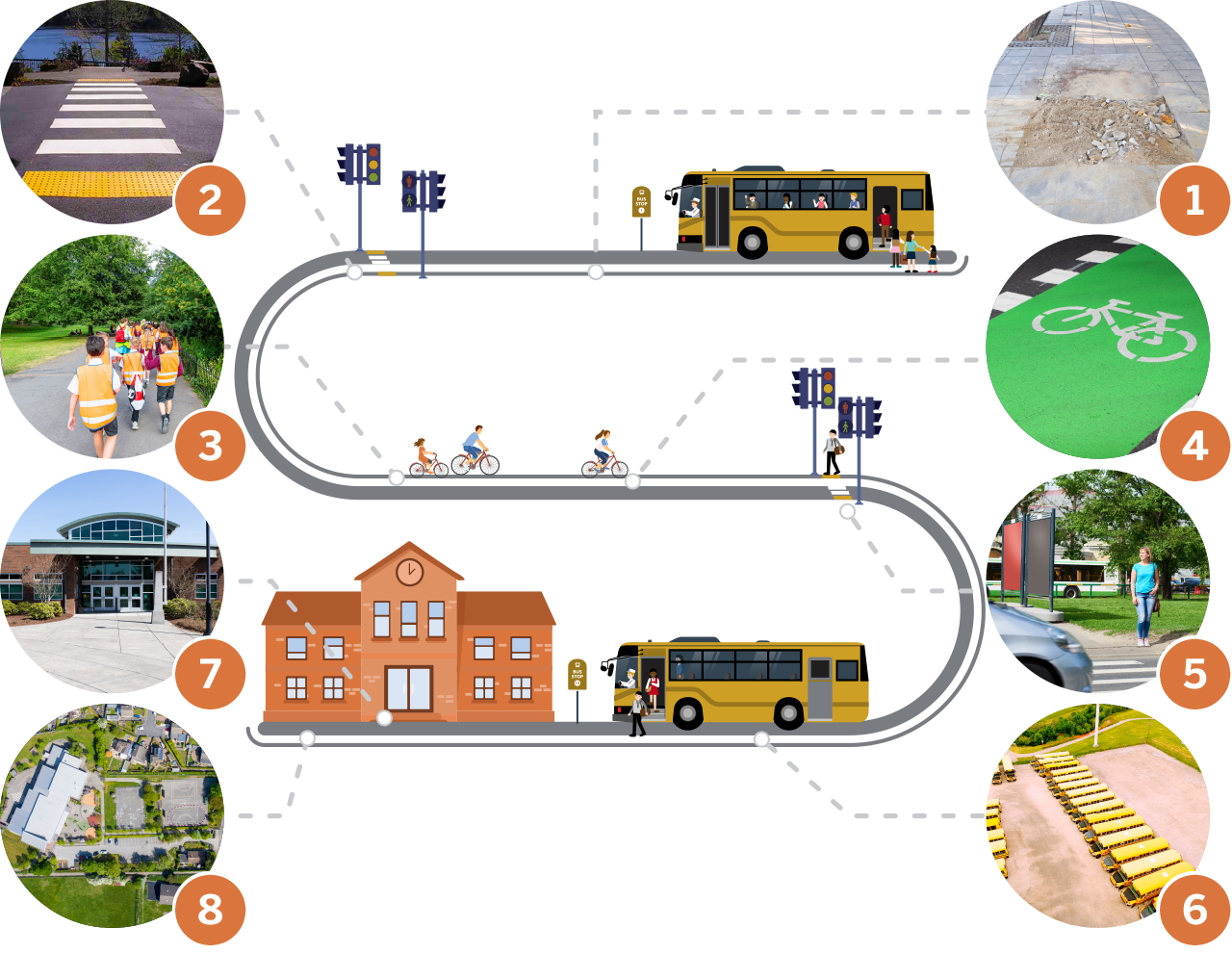

Did you notice any gaps, obstacles, or barriers in the traveled bicycle/pedestrian route?

Are the crossings accessible and well-positioned? For example, are they ADA compliant; do the signals provide enough crossing time; how many auto lanes are crossed; do parking, bus, or other activities obstruct sight lines; and are the crosswalk markings visible?

Is the route safe, well-lit, efficient, and clear in terms of directions?

What story do the traffic demands and other travel data around the school tell you?

How did you experience driver behavior during your audit?

What is the interaction like between the various modes of travel during drop-off/pick-up activity? Could vehicle/bus circulation patterns improve to make the area around the school safer for pedestrians and bicyclists?

Is the environment around the route safe and inviting?

Were there neighbors, businesses, or other related parties along the route who may be worth engaging with to learn their experiences, needs, and desires?
3. Understand the 6 Es
SRTS programs should be built around the 6 Es of Safe Routes to School. These principles summarize important components of a comprehensive and integrated program and are relied on at the federal, state, and local levels. Keep the 6 Es in your back pocket; assess and re-assess your efforts with each in mind.

Engagement
Build targeted engagement to educate drivers, bicyclists, and pedestrians alike. Examples include regular newsletters, community websites, sharing news during school events, and online surveys.

Equity
Your SRTS solutions should benefit all demographics; prioritize overcoming barriers and ensuring safe, healthy outcomes for low-income students, students of color, and others facing disparities.

Engineering
Engineering makes it possible to provide infrastructure improvements (e.g., crosswalks, bike lanes, signage, etc.) that make bicycle and pedestrian travel to school safe, efficient, comfortable, and fun.

Encouragement
Host events (e.g., walk or bike to school days) and activities to inspire interest in walking, biking, or rolling. Make sure to reward students for their participation. Promote the benefits of non-motorized travel!

Education
Teach students, parents, and community members about the transportation options available, share safety tips, and more. Consider walk-throughs, how-to videos, and other forms of education.

Evaluation
Whether surveys, pedestrian/bicycle traffic counts, or personal conversations with users, consistent evaluation of your program ensures each of the 6 Es are effective and intentionally pursued.
Safe Routes to School Demonstration Project | La Crescent, MN
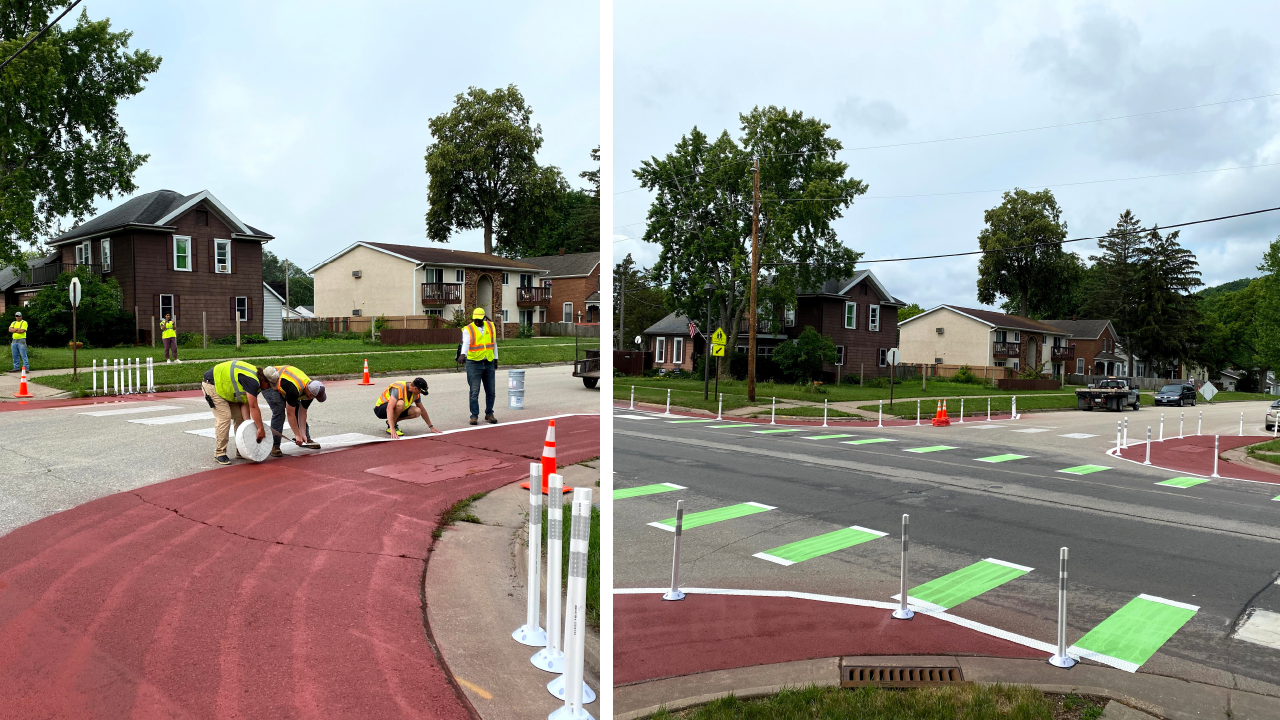
4. Apply for funding assistance and grants
Good news! Funding is often available to support your SRTS efforts. But it’s important to know where to look and when to begin seeking out/applying for grants, loans, and other financial support.
Congress created the federal SRTS program in 2005 as part of the federal transportation bill: Safe, Accountable, Flexible, Efficient Transportation Equity Act: A Legacy for Users. As highlighted in Section 1404, each state has flexibility in terms of how to develop funding application guidelines and how to distribute funds. For many states, applications to apply begin in the fall. In Minnesota, for example, some MnDOT applications become available in early October.
Depending on the state and year, funding may be available for your non-infrastructure projects – such as planning assistance grants, booster grants, and local coordinator grants. Other projects that may be available for funding include technical projects – such as demonstration projects like short-term, low-cost, temporary roadway projects and infrastructure projects like sidewalks, bicycle lanes, trails, and intersection improvements.
It’s important to stay on top of these deadlines and to understand the options available to you; if in need, consulting partners like SEH have experts who can guide you through the process.
Safe Routes to School Planning Project | Cities of Brainerd and Baxter, MN
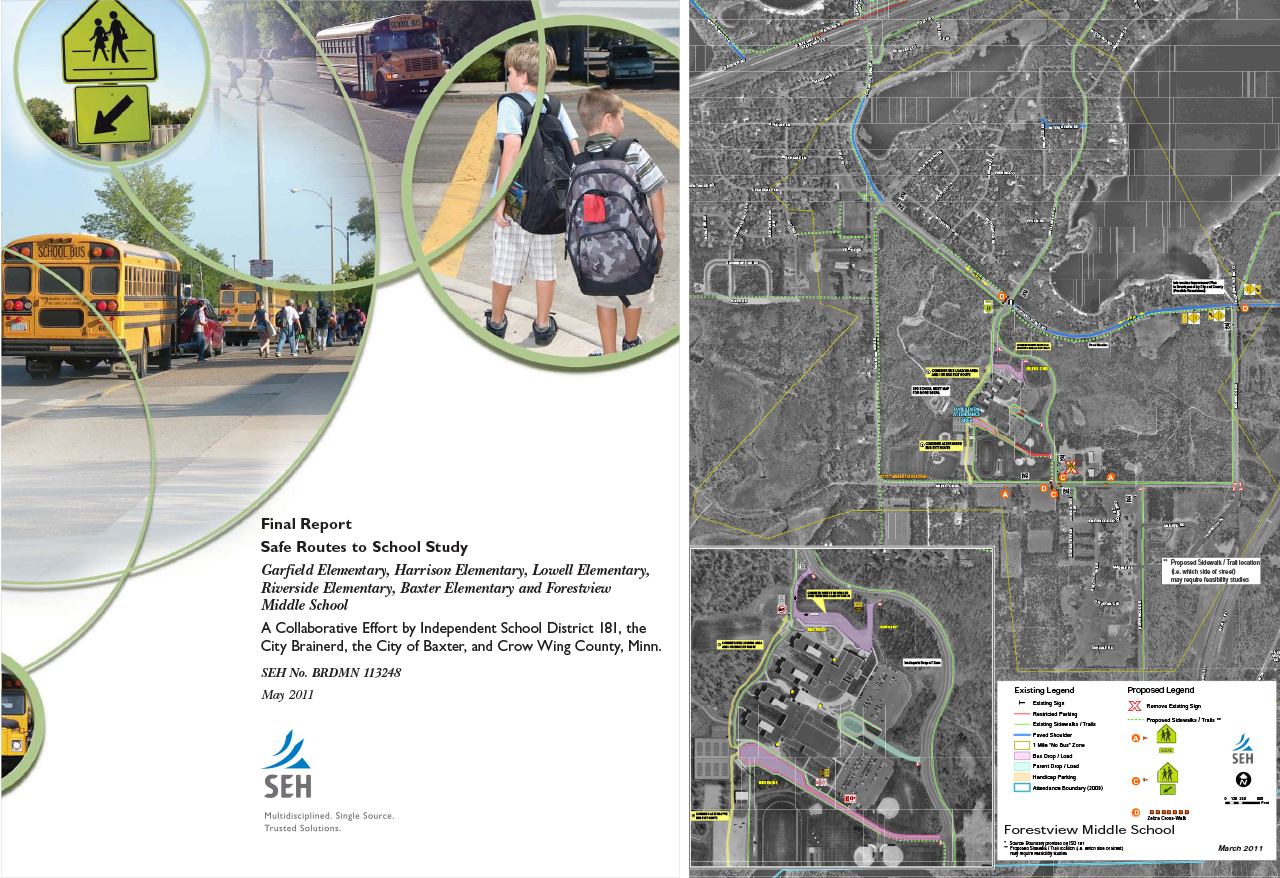
5. Act!
Creating an SRTS program may seem daunting, especially if you are just getting started. But acting can begin with simple yet important conversations about improving the safety of your students walking, biking, and rolling to/from your schools.
Consider the tools above, develop a team, and experience the area/neighborhoods surrounding your schools firsthand – each of these steps play a critical role as you work to improve safety, efficiency, and equity throughout your community and for your students.
Help is also available! At SEH, we are passionate about developing safe routes to school, equitable and inclusive communities, as well as complete streets. Our teams have walked many clients through the development of an SRTS program, from concept and funding to implementation and continuous evaluation. Beyond the safety benefits, we understand how to help SRTS programs create economic development opportunities, more efficient travel, and climate resilient communities.
Getting started
Need help getting started or have questions related to your SRTS program or anything you read above? Let’s connect and have a conversation!
About the authors

Erin Jordan, PE*, is a project manager and traffic engineer who specializes in traffic and transportation planning and design. Erin is experienced in and passionate about multimodal complete streets planning and partnering with communities to develop strategic SRTS programs that create safer, more efficient, opportunistic, and inclusive neighborhoods. She is currently working with MnDOT to provide technical design assistance for implementing SRTS Demonstration Projects throughout Minnesota.
*Registered Professional Engineer in IA, MN, WI

Heather Stabo, PE**, is a project manager and senior engineer with 12+ years of experience in roadway, civil site, multimodal path, bicycle, and pedestrian infrastructure design. This experience has provided Heather with the ability to deliver an array of features for streetscapes, parks, parking lots, and pathways. Heather also enjoys partnering with local communities by serving as a technical resource at public and stakeholder meetings.
**Registered Professional Engineer in WI


